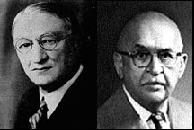Schmidt, Garden & Martin
 Richard Ernest Schmidt (1865-1958) was born in Bavaria, Germany, but his family moved to Chicago following the Civil War. He studied architecture at the Massachusetts Institute of Technology and worked for a number of architects (Adolph Cudell and Charles Sumner Frost) before starting his own practice in 1887. Eight years later, he asked Hugh Mackie Gorden Garden (1873-1961) to join him as chief of design. A native of Toronto, Canada, Garden had moved to Chicago in the late-1880s, apprenticing with several architectural firms, including Flanders & Zimmerman, Henry Ives Cobb, and Shepley, Rutan & Coolidge. He then became a freelance renderer, which brought him jobs with Howard Van Doren Shaw, Louis Sullivan, and Frank Lloyd Wright.
Richard Ernest Schmidt (1865-1958) was born in Bavaria, Germany, but his family moved to Chicago following the Civil War. He studied architecture at the Massachusetts Institute of Technology and worked for a number of architects (Adolph Cudell and Charles Sumner Frost) before starting his own practice in 1887. Eight years later, he asked Hugh Mackie Gorden Garden (1873-1961) to join him as chief of design. A native of Toronto, Canada, Garden had moved to Chicago in the late-1880s, apprenticing with several architectural firms, including Flanders & Zimmerman, Henry Ives Cobb, and Shepley, Rutan & Coolidge. He then became a freelance renderer, which brought him jobs with Howard Van Doren Shaw, Louis Sullivan, and Frank Lloyd Wright.
In 1906, the Schmidt-Garden partnership was formalized under the name of Richard E. Schmidt, Garden & Martin. The third partner was Edgar D. Martin (1871-1951), who later joined the firm of Pond & Pond. Schmidt brought business acumen and social connections to the partnership, while Garden brought the imagination, inventiveness, and sensitivity of a creative designer. Martin was an extremely skilled structural engineer who was able to solve technical problems associated with large industrial buildings and modern materials, such as the Montgomery Ward & Co. Catalog House (1908; 600 W. Chicago Ave.), one of the first buildings to be constructed of reinforced concrete.
Although known primarily for their commercial and industrial designs (e.g., Chapin and Gore, Schoenhofen Brewery Powerhouse), they also designed several residential buildings, more than 300 hospitals (e.g., Michael Reese; 1905; 2800 S. Ellis), and a few public structures. Garden, in particular, helped evolve the firm's progressive approach to design, much in the way that his contemporaries, Sullivan and Wright, had done. The style and details of Garden's architectural designs were so unique and distinctive that they often are referred to with the term "Gardenesque." The Prairie-style Humboldt Park Boathouse, Madlener House, and the Ward's Catalog House provide exceptional examples of this detailing.